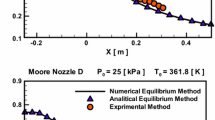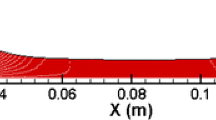Abstract
In this paper, the AUSM-van Leer hybrid scheme is extended to solve the governing equations of two-phase transonic flow in a steam turbine stage. The dominant solver of the computational domain is the non-diffusive AUSM scheme (1993), while a smooth transition from AUSM in regions with large gradients to the diffusive scheme by van Leer (1979) guarantees a robust hybrid scheme throughout the domain. The steam is assumed to obey non-equilibrium thermodynamic model. The effects of condensation on different specifications of the flow field are studied at subsonic/supersonic flow regimes. It is observed that as a result of condensation, the aerothermodymics of the flow field changes. For example in supersonic wet case (P b = 14.55 kPa), pressure loss coefficient of rotor and total entropy generation are, respectively, 77% and 29% more than those in dry conditions. Also the value of rotor deviation angle reaches 6.27° in wet case and P b = 14.55 kPa.
Similar content being viewed by others
References
A. G. Gerbar and M. J. Kermani, A pressure based Eulerian-Eulerian multi-phase model for non-equilibrium condensat1ion in transonic steam flow, International Journal of Heat and Mass Transfer, 47 (10) (2004) 2217–2231.
J. E. Mcdonald, Homogeneous nucleating of vapor condensation I & II, Kinetic & Thermodynamic aspects, American Journal of Physics, 30 (1962) 870–877.
M. J. Moore, P. T. Walters and R. I. Crane, Predicting the fog-drop size in wet steam turbines, International Mechanical Engineering Conference, Warwick (1973).
F. Bakhtar and M. R. Mahpeykar, On the performance of a cascade of turbine rotor tip section blading in nucleating steam, Part 3: Theoretical treatment, Proceedings of the Institution of Mechanical Engineers, Part C: Journal of Mechanical Engineering Science, 211 (3) (1997) 195–210.
F. Bakhtar, Z. A. Mamat, O. C. Jadayel and M. R. Mahpeykar, On the performance of a cascade of improved turbine nozzle blades in nucleating steam. Part 1: Surface pressure distributions, Proceedings of the Institution of Mechanical Engineers, Part C: Journal of Mechanical Engineering Science, 223 (8) (2009) 1903–1914.
F. Bakhtar, Z. A. Mamat and O. C. Jadayel, On the performance of a cascade of improved turbine nozzle blades in nucleating steam. Part 2: Wake traverses, Proceedings of the Institution of Mechanical Engineers, Part C: Journal of Mechanical Engineering Science, 223 (8) (2009) 1915–1929.
F. Bakhtar, M. Y. Zamri and J. M. Rodriguez-Lelis, A comparative study of treatment of two-dimensional two-phase flows of steam by a Runge-Kutta and by Denton’s methods, Proceedings of the Institution of Mechanical Engineers, Part C: Journal of Mechanical Engineering Science, 221 (6) (2007) 689–706.
J. B. Young, Critical conditions and the chocking mass flow rate in non-equilibrium wet steam flows, Journal of Fluids Engineering, 106 (4) (1984) 452–458.
J. B. Young, Two-dimensional, non-equilibrium, wet-steam calculations for nozzles and turbine cascades, ASME Journal of Turbomachinery, 114 (1992) 569–579.
A. G. Gerber, Two-phase Eulerian/Lagrangian model for nucleating steam flow, Journal of Fluids Engineering, 124 (2) (2002) 465–475.
B. Nikkhahi, M. Shams and M. Ziabasharhagh, A numerical investigation of two-phase steam flow around a 2-D turbine's rotor tip, International Communications in Heat and Mass Transfer, 36 (6) (2009) 632–639.
J. Halama, F. Benkhaldoun and J. Fort, Flux schemes based finite volume method for internal transonic flow with condensation, International Journal for Numerical Methods in Fluids, 65 (8) (2011) 953–968.
S. Dykas and W. Wroblewki, Single-and two-fluid models for steam condensing flow modeling, International Journal of Multiphase Flow, 37 (9) (2011) 1245–1253.
M. S. Liou and C. J. Steffen, A new flux splitting scheme, Journal of Computational Physics, 107 (1) (1993) 23–39.
R. Radespiel and N. Kroll, Accurate flux vector splitting for shocks and shear layers, Journal of Computational Physics, 121 (1) (1995) 66–78.
M. S. Liou, A sequel to AUSM, Part II: AUSM+-up for all speeds, Journal of Computational Physics, 214 (1) (2006) 137–170.
P. Halder, K. P. Sinhamahapatra and N. Singh, Numerical investigation of supersonic wake of a wedge using AUSM+ scheme on unstructured grid, International Journal of Applied Mathematics and Mechanics, 7 (11) (2011) 46–68.
M. J. Kermani and A. G. Gerber, A general formula for the evaluation of thermodynamic and aerodynamic losses in nucleating steam flow, International Journal of Heat and Mass Transfer, 46 (17) (2003) 3265–3278.
J. P. Sislian, Condensation of water vapor with or without a carrier gas in a shock tube, UTIAS Report 201, Toronto University (1975).
J. D. Anderson, Computational fluid dynamics; The basics with applications, McGraw-Hill (1995).
B. Van Leer, Towards the ultimate conservation difference scheme. V. A second order sequel to Godunov’s method, Journal of Computational Physics, 32 (1) (1979) 101–136.
W. Traupel, Die grundlagen der thermodynamik, G. Baun-Verlag Karlsruhe (1971).
F. Bakhtar, M. Ebrahimi and R. A. Webb, On the performance of a cascade of turbine rotor tip section blading in nucleating steam, Part 1: Surface pressure distributions, Proceedings of the Institution of Mechanical Engineers, Part C: Journal of Mechanical Engineering Science, 209 (2) (1995) 115–124.
R. Kiock, F. Lehthaus, N. C. Baines and C. H. Sieverding, The transonic flow through a plane turbine cascade as measured in four European wind tunnels, Journal of Engineering for Gas Turbines and Power, 108 (2) (1986) 277–284.
Author information
Authors and Affiliations
Corresponding author
Additional information
Hamed Bagheri-Esfe is a Ph.D. candidate in mechanical engineering at the Amitkabir University of Technology. He completed his B.Sc. in Mechanical Engineering (Thermal-Fluid) from the Kashan University and his M.S. in mechanical engineering from Birjand University (1st in rank). For his Ph.D. program, he is working on effects of non-equilibrium condensation in steam turbines. His fields of interest include computational fluid dynamics, compressible flows and two-phase flows.
Mohammad Jafar Kermani is an Associate Professor at the Amirkabir University of Technology. He completed his BSc in Mechanical Engineering (Thermal- Fluid) from the Shiraz University (2nd in rank), his M.S. in Applied Mathematics from Manchester University (1st in rank), and his Ph.D. from Carleton University. Then, he pursued a two-year postdoctoral fellowship at the University of New Brunswick, Canada on steam turbines and proton exchange membrane fuel cells. He has written over 100 papers and has supervised more than 70 students.
Majid Saffar-Avval is a professor of mechanical engineering at the Amirkabir University of Technology (AUT), Tehran, Iran. He received his B.Sc. and M.Sc. degrees from Sharif University of Technology, and his Ph.D. degree from the Ecole Nationale des Arts et Metiers (ENSAM), Paris, France, in 1985. He has been teaching at the AUT since then. He was head of the Mechanical Engineering Department from June 2000 to June 2002 and head of the Energy and Control Center of Excellence from May 2007 to March 2012 at AUT. His research contributions are in the field of two-phase heat transfer, advanced thermal systems and energy management.
Rights and permissions
About this article
Cite this article
Bagheri-Esfe, H., Kermani, M.J. & Saffar-Avval, M. Effects of non-equilibrium condensation on deviation angle and efficiency in a steam turbine stage. J Mech Sci Technol 30, 1351–1361 (2016). https://doi.org/10.1007/s12206-016-0242-2
Received:
Revised:
Accepted:
Published:
Issue Date:
DOI: https://doi.org/10.1007/s12206-016-0242-2




